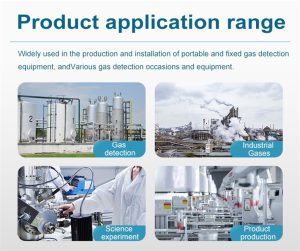The safety of industrial environments is of paramount importance. With the continuous advancements in gas sensor technology, the future of industrial protection holds great promise. Gas sensors play a crucial role in detecting and monitoring potentially hazardous gases, ensuring the safety of workers, preventing accidents, and mitigating environmental risks. This article explores how gas sensors are enhancing safety in industries and discusses their potential in shaping the future of industrial protection.
The Importance of Gas Sensors in Industrial Settings:
Industrial environments often involve the presence of various gases that can be harmful or even deadly. Toxic gases, flammable substances, and explosive vapors pose significant risks to worker safety and facility integrity. Gas sensors provide an early warning system, detecting the presence of these gases and triggering alarms or automatic systems to prevent accidents. Through real-time monitoring, gas sensors enable proactive measures to maintain a safe working environment.
Detection and Monitoring Capabilities:
Gas sensors are designed to detect specific gases and measure their concentration levels. They utilize different technologies, such as electrochemical, catalytic bead, infrared, and photoionization detection, each suited for particular applications. These sensors can detect a wide range of gases, including carbon monoxide, hydrogen sulfide, methane, ammonia, and volatile organic compounds (VOCs). The advancements in gas sensor technology have improved their accuracy, sensitivity, selectivity, and response time, making them more reliable in detecting even trace amounts of hazardous gases.
Real-time Monitoring and Data Analysis:
Modern gas sensors are equipped with advanced data logging and communication capabilities, allowing for real-time monitoring and analysis. Gas sensor networks can be integrated with central control systems, enabling continuous monitoring of multiple areas within an industrial facility. The data collected provides valuable insights into gas concentrations, trends, and potential risks. By analyzing this data, safety managers can identify patterns, assess risks, and implement appropriate safety measures to prevent accidents and protect workers.
Wireless and IoT Integration:
Wireless technology has revolutionized gas sensor systems, making it easier to deploy and manage them in industrial settings. Wireless gas sensors eliminate the need for extensive wiring, reducing installation costs and providing flexibility in sensor placement. Additionally, gas sensor networks can be seamlessly integrated into the Industrial Internet of Things (IIoT), allowing for centralized monitoring and control. This integration enables remote access to real-time data, alerts, and notifications, empowering safety managers to make informed decisions and take immediate actions to ensure worker safety.
Enhanced Worker Safety and Accident Prevention:
Gas sensors play a crucial role in enhancing worker safety by detecting and preventing potential hazards. With real-time monitoring, these sensors can identify unexpected gas leaks, faulty equipment, or process malfunctions that may lead to accidents. Once a hazardous condition is detected, gas sensors can trigger immediate actions such as activating ventilation systems, shutting down equipment, or initiating evacuation procedures. By providing early warnings, gas sensors enable timely interventions to mitigate risks and prevent accidents, safeguarding the well-being of workers.
Environmental Protection:
In addition to ensuring worker safety, gas sensors contribute to environmental protection in industrial settings. Monitoring and controlling gas emissions help reduce pollution, comply with environmental regulations, and minimize the impact on surrounding ecosystems. Gas sensors can detect fugitive emissions, leaks, or improper combustion processes, enabling companies to implement corrective measures and improve their environmental footprint.
Future Implications and Innovations:
The future of gas sensor technology holds numerous possibilities for advancing industrial safety. Ongoing research focuses on developing more robust and sensitive sensors capable of detecting a wider range of gases. Miniaturization and integration with wearable devices will provide workers with personal gas monitoring systems, enhancing their safety in hazardous environments. Furthermore, advancements in machine learning and artificial intelligence will enable gas sensors to learn from historical data, predict potential hazards, and offer proactive safety recommendations.
Conclusion:
Gas sensors are indispensable tools in ensuring the safety of industrial environments. With their detection and monitoring capabilities, real-time data analysis, wireless integration, and potential for future innovations, gas sensors are shaping the future of industrial protection. By continuously advancing the technology, industries can enhanc
 : +86 155 8830 2704
: +86 155 8830 2704 : jxdziot@gmail.com
: jxdziot@gmail.com
